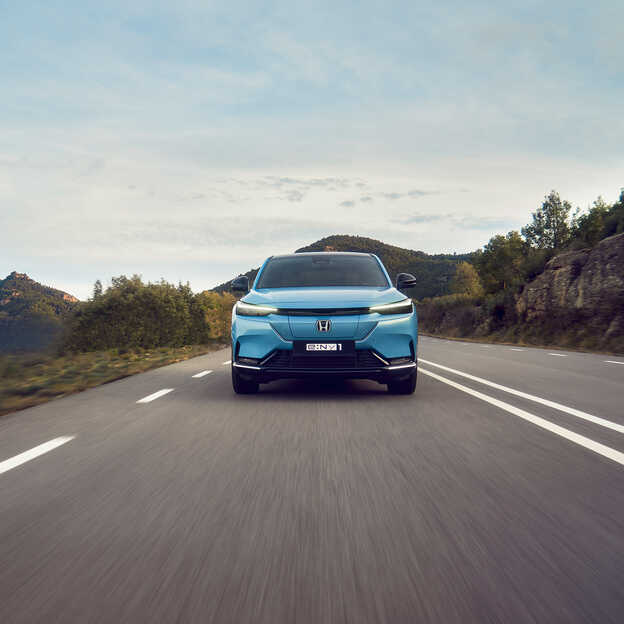EV Public Charge Points: Everything You Need To Know
Thinking about buying an electric vehicle (EV) but unsure about how public charging works?
In this article, learn about the different types of public chargers, where to find them, how long public charging takes, and how to pay.
Where can I charge an electric vehicle in public?
There are various types of public EV charging stations across the UK.
EV charging points are available in various places, from service stations to supermarket car parks, shopping centres, public parking lots and the side of motorways. There are also many different types of charging networks.
In the UK, some of the most common include:
- bp pulse
- Pod Point
- Shell Recharge
- Instavolt
- Gridserve
- Osprey
Depending on which country you’re in, there may also be other prominent EV charging networks available, such as Enel X in Italy, EnBW in Germany and Corri-Door in France.
These networks can be found on multiple apps, such as Chargemap, which lets you know where your nearest charging station is across the European charging network.
Alternatively, search for car parks, supermarkets, retail parks and holiday accommodations with free public EV charging points whenever you make a long journey, and you could save yourself some money.
What are the different types of public chargers?
Public chargers can be categorised primarily into two types based on their output capacity in kW.
It’s important to note that an EV’s charging speed is limited by its own onboard charger capacity. An EV cannot charge at a faster rate than that, even if plugged into a high-capacity charger.
Normal chargers
Normal Public chargers, also known as Level 2 chargers or Type 2 charging points can range in output from 7kW to 22kW and are the most common type of public charging points These types of public EV chargers are commonly located in areas such as car parks and supermarkets, garage forecourts, retail parks, restaurants and other convenient public locations.
The charging speeds are compatible with most EV batteries.
Rapid chargers or Fast chargers
Rapid charging points, also known as DC charging points or Level 3 chargers, can have an output of 50kW or higher. Ultra-rapid chargers, meanwhile, can have an output of anywhere between 100kW and 350kW. These are most typically found on motorways. In the UK, most motorway service areas now have rapid or ultra-rapid chargers, with many offering 150kW or above.
*Zap-Map
How long does charging an EV at a public station take?
Charging times at public stations primarily depend on your EV’s charging capacity, which should ideally match the charger's output for the fastest results. Here’s a breakdown of approximate charging times under ideal conditions.*
Ultra-rapid chargers
100-350kW
20-30 mins
Rapid chargers
50kW
35 mins
Fast chargers
7-22kW
3-4 hrs
Slow chargers
3-7kW
6-12 hrs
*Note: Under ideal conditions, such as a temperature between 20°C and 30°C, a charge from 10% to 80% can be achieved in around 30 minutes with a 150kW DC charger. However, actual times may vary due to factors such as the age, type, and condition of the charger and battery, as well as the outdoor temperature and the starting charge. Charging times can be longer in colder weather or if battery protection systems activate to prevent overheating.
How do you pay for public EV charging?
Depending on your preference and the availability at your chosen recharge station, you can pay for public EV charging via an app, key fob, credit or debit card or subscription service.

Charging apps
The most common way to pay is via a dedicated app. There are multiple apps available, each of which lets you authenticate yourself at the charging station and make payments. Some apps will require you to pay a monthly membership or subscription fee, or you may be able to access the app and pay per use. Typically charging rates will be slightly lower with a subscription. Some of the most popular charging apps include:
Key fob or RFID card
Some charge point operators may issue you with a key fob or RFID card to enable you to authenticate your EV charging payments. Simply swipe the card or fob over the reader, and the charging station will recognise who you are and where the bill needs to go. Just like an app, you should be able to choose between pay-as-you-go or membership.


Credit or debit card
Paying directly using a card is often the fastest way to pay for electric vehicle charging, but it might not offer the best rates. Some apps allow you to authenticate your session and then pay by card, providing exclusive discounts when you do so.
FAQs
Can I charge my electric car in the rain?
Yes, you can charge your electric car in the rain. Modern EV hardware is designed to withstand wet weather, including cables and connectors.
Do I need a special cable to charge my car at a public station?
You don’t necessarily need a special cable to charge your car at a public station, as most will come equipped with a range of chargers and connectors. However, some may require you to have your own cable, so it’s always worth having one with you.
Are public chargers compatible with all electric cars?
Most public charging stations have Level 1 or Level 2 chargers, and the majority of electric cars are compatible with these. Not all cars will be compatible with certain ultra-rapid or DC chargers, but these are the least common in public stations.
Related reading
Honda Electric Range Overview
27.11.25
|
10 min
Understanding UK Government support for EVs

12.08.25
|
10 min
Dispelling 10 common EV myths

15.04.25
Honda 0 series
.jpg/_jcr_content/renditions/c2_r.jpg)
07.10.24
Are all electric cars automatic?

23.09.24
Honda e:PROGRESS

25.03.24
Electric Car Charging in Europe Guide


